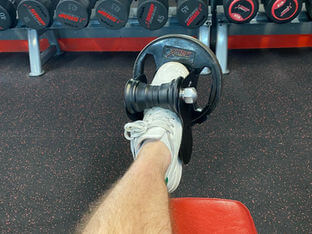Shin splints? Painful knee with jumping? Recurrent ankle sprains? These are the types of injuries we fix day in and day out at Praxis Physio. There are number of recommended paths for rehabilitation in theses injuries backed by the research and our clinical experience, but has the evidence been missing something? There is some social media traction in the fitness and exercise world recently around tibialis anterior (TA) loading as a ‘cure all’ for every lower limb injury. Being the physio nerds that we are, we looked in to it for you!
The tibialis anterior is located on the front (anterior) portion of the shin (tibia) – hence the name. Its role is to lift the foot (dorsiflex) the ankle as well as provide some stability for the outside of the ankle . This action is key for movements in walking and running especially in negotiating steps and hills as the foot needs to clear a certain height before landing. It is also very important in landing from a height and changing directions rapidly, as it acts as shock absorber for the knee and ankle joints (reference).
Like any muscle or joint in the body, the TA is not without its problems. Physios are regularly confronted with patients who complain of pain and stiffness around the muscles of the shin. Such conditions may include shin splints, compartment syndrome, patellofemoral pain syndrome (aka runner’s knee) and general ankle joint pain and stiffness post ankle sprain.
As mentioned, there has been a lot of discussion lately in the strength and conditioning community about whether training this muscle can prevent or treat musculoskeletal conditions, such as the ones mentioned above. Anecdotally, training of the TA has been described several benefits. Specific athletes have explained that they have seen improvements in vertical jump height, running speed, running stamina and squat depth. From a prevention and treatment point of view, it has been said that training the TA has helped improve symptoms associated with knee pain, ankle pain and shin splints. Also let us not forget, that from an aesthetics point of view, a strong and bulky looking TA does make our legs look more attractive, as bodybuilders would argue.
Unfortunately, the scientific community has not provided strong evidence that training the TA can aid in affecting the above musculoskeletal pathologies, or attain the performance benefits. So what do we know from previous scientific literature? Well, Munoz et al (2015) describes the tibialis anterior as key during an efficient gait cycle as well as being critical for balance control. Furthermore, an increase in strength of the TA helps greatly reduce the risk of falling. Maharaj et al (2019) confirms that during walking and running , TA’s tendinous tissue absorbs energy during contact and controls foot position during swing.
The proposed mechanisms to aid in athletic performance include:
- Increased ankle stability: Strong tibialis anterior muscles provide better stability to the ankle joint during jumping movements. This stability allows for improved force transmission from the lower leg to the foot, enabling athletes to generate greater power and maintain proper alignment during takeoff and landing.
- Enhanced dorsiflexion range of motion: Adequate dorsiflexion range of motion is essential for optimal jumping performance. Strengthening the tibialis anterior helps to improve flexibility and mobility in the ankle joint, allowing athletes to achieve a greater degree of dorsiflexion during the pre-jump phase. This increased range of motion enables a longer and more powerful push-off, resulting in higher jumps.
- Improved jump height and explosive power: The tibialis anterior plays a significant role in generating propulsive force during the takeoff phase of a jump. By strengthening this muscle, athletes can produce a more forceful and efficient push-off, leading to increased jump height and explosive power. The ability to generate greater force through dorsiflexion contributes to a more powerful and effective jump.
- Injury prevention: Weak tibialis anterior muscles can contribute to imbalances in the lower leg, potentially leading to various conditions such as shin splints or ankle sprains. Strengthening this muscle group helps to maintain proper muscle balance around the ankle joint, reducing the risk of injuries that could hinder jumping performance.
So if we are to believe TA holds the key to athletic performance and injury mitigation, how do we unlock it?
To strengthen the tibialis anterior, physiotherapists often prescribe specific exercises that target this muscle, such as toe raises, resisted dorsiflexion exercises, or using resistance bands to provide resistance during dorsiflexion movements. These exercises should be performed in a controlled manner and progressively increased in intensity to promote muscle strength and endurance. Below you see variations on how you can load the TA and progress and regress it respectively. Remember that we need to treat the TA like any other muscle we are wanting to train – progressively overloading it!
As Physiotherapists, we greatly value and adhere to evidence-based practice, however one could argue that this particular muscle has not received the scientific study treatment it rightly deserves. So if you are having some lower leg issues, or haven’t quite got that bounce you are wanting, come and chat to one of our friendly and knowledgeable staff. We can do a full assessment and put the spring back in your step!
Until next time, Praxis what you preach!
Prevent. Prepare. Perform
References:
Maharaj JN, Cresswell AG, Lichtwark GA. Tibialis anterior tendinous tissue plays a key role in energy absorption during human walking. J Exp Biol. 2019 Jun 4;222(Pt 11):jeb191247. doi: 10.1242/jeb.191247. PMID: 31064856.
Ruiz Muñoz, M., González-Sánchez, M. & Cuesta-Vargas, A.I. Tibialis anterior analysis from functional and architectural perspective during isometric foot dorsiflexion: a cross-sectional study of repeated measures. J Foot Ankle Res 8, 74 (2015). https://doi.org/10.1186/s13047-015-0132-3

